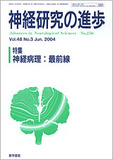Japanese
English
- 有料閲覧
- Abstract 文献概要
- 1ページ目 Look Inside
神経変性疾患では,神経細胞脱落を指標とする病変分布が病態の本質に関連する病理所見として考えられてきた。ポリグルタミン病は,CAGリピートの異常伸長を共通原因とする遺伝性脊髄小脳変性症であり,歯状核赤核淡蒼球ルイ体萎縮症,ハンチントン病など少なくとも9疾患が属している。これらの疾患では,変異蛋白質の神経細胞核内への蓄積が病態の本質と考えられているが,その病態を指標として検討された各疾患の病変分布は,細胞脱落に基づく従来の変性部位をはるかに凌駕していた。ポリグルタミン病の真の病変分布とは何か。原因遺伝子発見を契機に,遺伝性脊髄小脳変性症の病理学的再評価が進行している。
The expansion of a CAG repeat that codes for polyglutamine is a common gene mutation in the family of hereditary neurodegenerative diseases that includes dentatorubral-pallidoluysian atrophy(DRPLA), Machado-Joseph disease(MJD)and Huntington's disease. It is recognized that intranuclear accumulation of mutant proteins with expanded polyglutamine stretches is a pathological characteristic of neurons in CAG repeat diseases. In DRPLA, this nuclear pathology involves many neurons in various nervous system regions, such as the cerebral cortex, thalamus, substantia nigra and pontine nuclei in addition to the previously recognized affected regions. It has been revealed that the dentatorubral and pallidoluysian systems are the regions in which more than 60%of neurons are constantly involved by the pathology. In contrast, affected neurons in some regions such as the cerebral cortex extremely vary in number depending on the size of CAG repeat. These situations may be responsible for a variety of phenotypes, such as dementia and epilepsy in the subtypes of DRPLA. The expansion of potential CNS lesions assessed by this nuclear pathology is also demonstrated in MJD, Huntington's disease. In CAG repeat diseases, the variable prevalence of this characteristic may be relevant to the variation of clinical symptoms in patients with different repeat sizes.

Copyright © 2004, Igaku-Shoin Ltd. All rights reserved.


